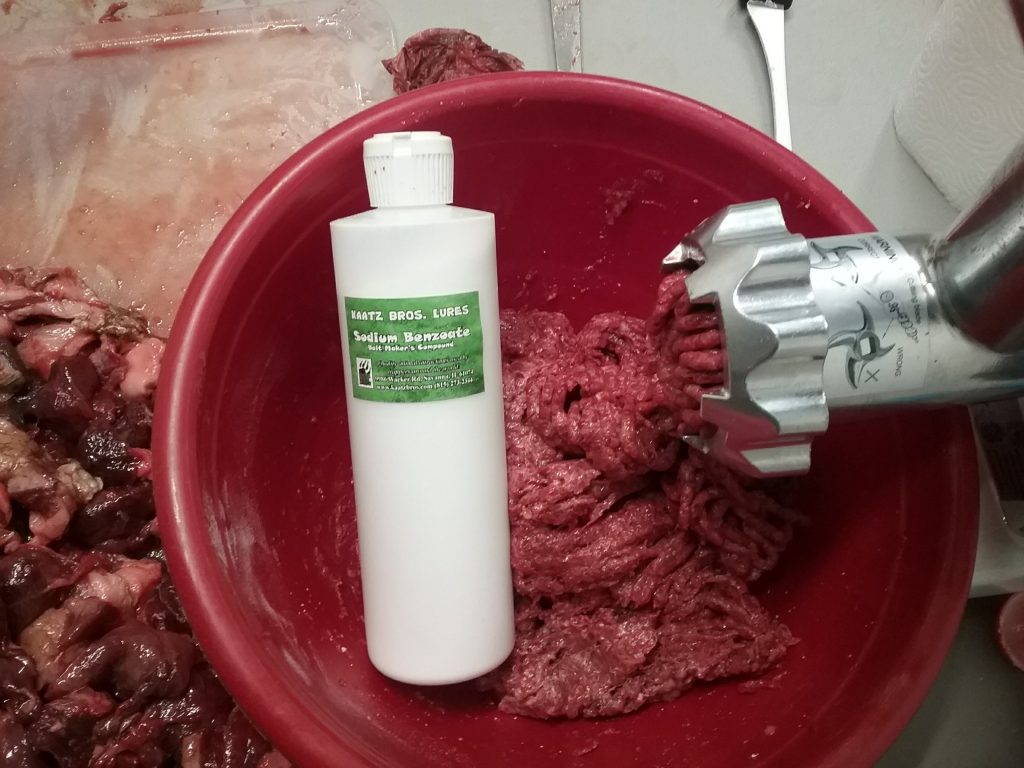This site is supported by you, the reader. If you make a purchase through one of my links, I may earn a small commission. Learn more here.
 In a perfect world, we trappers would have all the bait we need, from the animal we want to use, at the desired level of freshness or taint, just at the moment we need to deploy it on the trap line. But we know that’s totally impossible, so bait preservation is a must. Preserving bait, quite simply, is what we do to keep it from rotting. Left to its own devices, meat will rot and spoil, and while rotten meat has its place in some situations, it generally isn’t a desired trapping bait for most species. Instead, we want it either fresh or slightly tainted (beginning to break down and putting out an increased odor). Being able to preserve bait gives us the flexibility to collect meat when it’s available, and keep it until we need it during trapping season. In fact, properly preserved bait can often continue to be used for years!
In a perfect world, we trappers would have all the bait we need, from the animal we want to use, at the desired level of freshness or taint, just at the moment we need to deploy it on the trap line. But we know that’s totally impossible, so bait preservation is a must. Preserving bait, quite simply, is what we do to keep it from rotting. Left to its own devices, meat will rot and spoil, and while rotten meat has its place in some situations, it generally isn’t a desired trapping bait for most species. Instead, we want it either fresh or slightly tainted (beginning to break down and putting out an increased odor). Being able to preserve bait gives us the flexibility to collect meat when it’s available, and keep it until we need it during trapping season. In fact, properly preserved bait can often continue to be used for years!
There are a few key methods to preserve bait. If you want to make things really simple, you can just put your bait in the freezer. That’s not practical for most of us, though. Who has the extra chest freezers, and is willing to keep them running all summer, to store a bunch of trapping bait? In some cases freezing meat is a viable option, if you have the space, and especially if you’re only several weeks away from the start of the season. In fact, you may get the bait out just in time to make room in that freezer for all the fur you’re about to catch!
Outside of the freezer method, there are three main ingredients trappers can use to preserve bait, and these are also commonly used to preserve different types of trapping lures – Salt, Sodium Benzoate, and Methyl Paraben.
Salt is the cheapest and most readily available bait preservative. It’s commonly used to preserve glands (another topic), but has also been a great utility for meat preservation by humans throughout history. So it makes sense that it would work to preserve trapping bait. A good rule of thumb is to mix about 1 part salt to 4 parts meat when working with ground-up meat, and if preserving large chunks of meat, I simply apply alternating layers of salt and meat in a wide plastic tub, and then mix all together, ensuring that all of the meat surfaces have contact with the salt. While the ground meat method seems to work better, both should get the job done. You can get large quantities of salt (use un-iodized) in 50 lb bags at your local feed store, usually for less than $10.
Sodium Benzoate is the most commonly used preservative in the bait making industry. It is available as a powder, and costs more than salt, but far less quantity is needed for a given amount of meat and it doesn’t give off as much of the salty-flavor and smell that salt does. One ounce sodium benzoate per quart of bait is the recommended dose.
Methyl Paraben (link to Ebay) is similar to sodium benzoate, except that it doesn’t have any of the salty odor or taste, because it’s not a salt. It’s much more expensive than sodium benzoate, and the same quantity is recommended: one ounce methyl paraben per quart of bait. Due to its high cost, this is usually only used when it’s critical to avoid any salty flavor.
By following the above guidelines, you’re well on your way to preserving bait well in advance of trapping season. A few additional guidelines: never allow flies to get to the meat, and seal it well once preserved, both to keep moisture in and keep bugs and predators out. I seal my bait in a heavy duty plastic bag, placed inside a 5 gallon bucket or heavy duty plastic tote, with lid attached and taped on, if necessary. Good luck!
Leave a Reply